On January 10, 2019, Jim Cramer of CNBC’s Mad Money recommended that Apple buy Epic, a market leader in EHRs. At that moment in the Twitterverse, it occurred to me that health IT as a consumer-facing industry was beginning to mainstream in America.
Cramer’s pronouncement led to a tweetstorm where hundreds of tweeters in and outside of health/care talked back and with Cramer.
A few of my favorite comments were:
- “Jim Cramer needs a crash course in FHIR standards” from the wonkier section of peanut gallery.
- “They are not even in the same universe” among people dissing the idea in short-hand.
- “Where is the iPhone listed on Maslow’s hierarchy of human needs?” from someone noting Apple fans’ brand-love.
- “Epic has too much technical debt and would be a mess for Apple” for those with a strategic bent.
- Then the final consensus that, Epic, at the end of the day, would “never sell,” which most health IT insiders confidently asserted.
Here’s what I wrote.
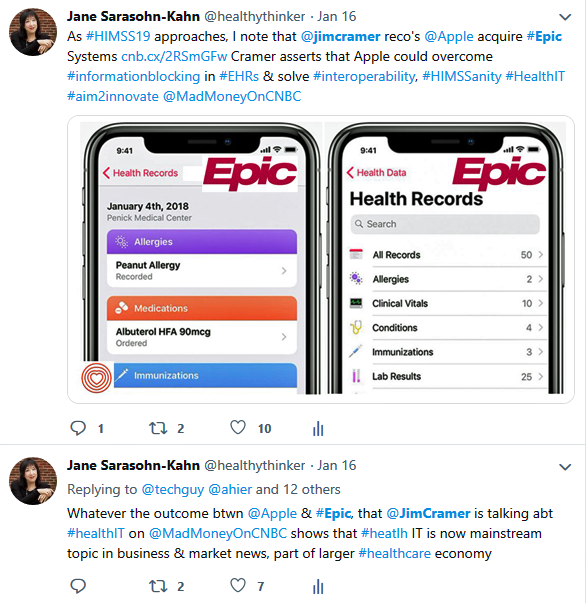
My longtime health IT pal John Lynn wrote an entire treatise on “why” this just couldn’t/wouldn’t happen. Brian Ahier, another close collaborator, asserted that “Judy” (Faulkner), Epic’s CEO, would have nothing to do with such a deal would go against the company’s legal foundation structure. Cramer later tweeted that such arrangements could change, on January 16th asserting, “I still say never say never.”
As I approach my 20-somethingth HIMSS, having been a member of the organization for most of my professional life, I’ll be focusing on the mainstreaming health IT Zeitgeist as I meet with innovators and experts this week in Orlando. I’m keen to learn where the industry is on that diffusion curve in putting health information and tools into the hands of consumers, patients and caregivers.
Why is this so important? I’ll give you four big reasons:
The patient is expecting a consumer experience from health care.
The patient is worried about privacy and data security.
The patient is growing aware of her personal “data space.”
The patient is a payor.
The patient-consumer experience. Central to this theme on the HIMSS exhibition floor will be the Personalized Health Experience at Booth 888 in Hall A. I spent time on the phone before the conference with John Sharp of HIMSS. John has been hands-on in curating the participants in this space, which John said are moving care outside of the hospital into peoples’ homes and hands across the continuum. In addition to exhibits, there’s a full agenda of sessions that focus on consumer health at home. A few topics that pique my interest address benefits for people and their pets, AI for everyday peoples’ health, and the assertively (spot-on) titled session, “don’t build more healthtech without asking patients first.”
Patient’s privacy and data security. Personalized health in the context of connected health means the flow of personal data, and this is another theme I’ll be exploring at HIMSS19 in terms of privacy, security, and consumer data ownership and control. We know that the volume of cybersecurity breaches against healthcare providers and plans has escalated year over year. One reason is because a medical data breach is more valuable than a hack of, say, consumers’ credit card identities. There will be a slew of data security solutions to evaluate at this conference. I expect a large proportion of HIMSS19 attendees will be at the conference focusing on just this challenge, the response to which can make-or-break a provider’s reputation in their local market.
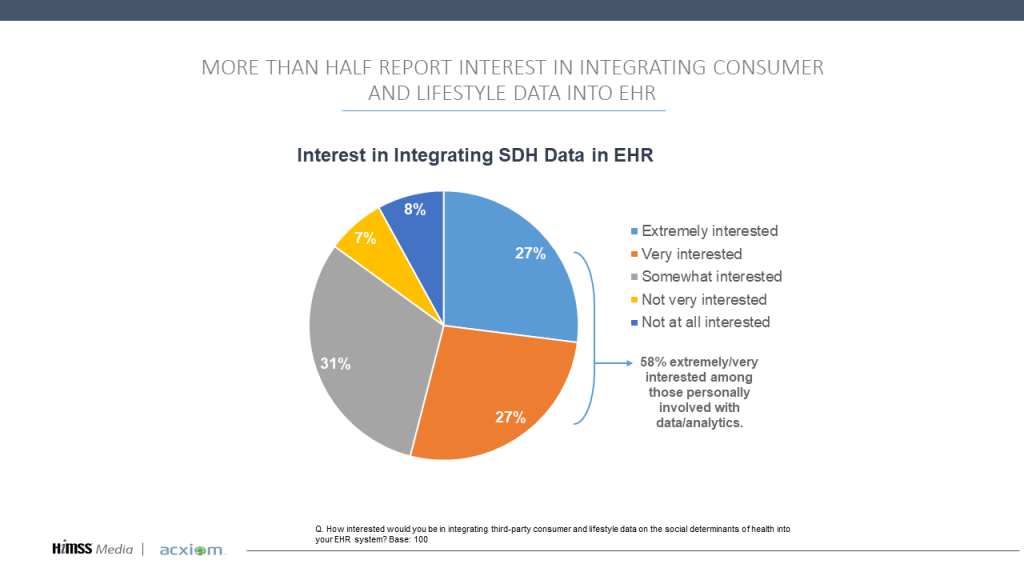 The patient’s personal data-space. In the post-Facebook/Cambridge Analytics era, people have sobered up on the issue of the value of their data and respect for their ability to control and even monetize the value of that information. This is subtler than the data breach challenge. It’s related to Big Data algorithms and analytics that health care stakeholders assuming financial risk employ to manage that risk. More companies that supply the healthcare industry with personal data beyond the health care claim are exhibiting at HIMSS19. Several big-name vendors in this space that are also speaking on the importance of gathering and using personal consumer data from retail, wearable tech, and other non-healthcare sources. LexisNexis has already garnered attention on this topic in a Politico story published earlier this month on the company’s approach to calculating a personal score for opioid risks.
The patient’s personal data-space. In the post-Facebook/Cambridge Analytics era, people have sobered up on the issue of the value of their data and respect for their ability to control and even monetize the value of that information. This is subtler than the data breach challenge. It’s related to Big Data algorithms and analytics that health care stakeholders assuming financial risk employ to manage that risk. More companies that supply the healthcare industry with personal data beyond the health care claim are exhibiting at HIMSS19. Several big-name vendors in this space that are also speaking on the importance of gathering and using personal consumer data from retail, wearable tech, and other non-healthcare sources. LexisNexis has already garnered attention on this topic in a Politico story published earlier this month on the company’s approach to calculating a personal score for opioid risks.
Acxiom will host a lunch-and-learn on “Using Data to Overcome the Barriers to Patient-Driven Experience.” Ahead of HIMSS19, Acxiom published a paper on this topic, summarizing a HIMSS survey on social determinants of health and data analytics. As the pie chart from the study result illustrates, well over one-half of health care providers are interested in integrating SDOH data into the EHR. With this growing demand on the provider side, it will be critical for providers – who currently enjoy a trusted relationship as patient data steward – to ensure consumers understand how their personal data is being used, and what rights people have over their data. The fact is that HIPAA may not cover all of these data flows. Consumers should be informed that their providers are using these data in the context of their health and health care in a value exchange. This area will get more attention as patients become more aware of personal data from retail receipts and social network check-ins being used in disease management, wellness programs, or other uses that might do well to receive a patient opt-in in advance of using PHI beyond HIPAA’s embrace. I covered this topic in my paper, Here’s Looking At You, prepared for the California Healthcare Foundation. The cautions I raised in that paper five years ago remain unresolved in U.S. privacy law.
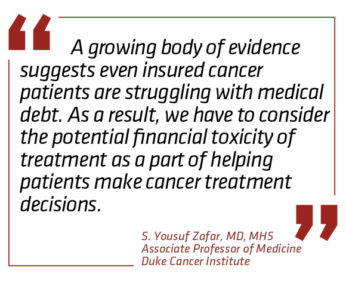 The patient as payor. Americans don’t save much relatively to peers in other developed countries (even compared to health citizens living in highly-taxed Scandinavia). Revenue cycle management (RCM) is a big HIMSS theme from providers’ points of view. But patients are now payors, facing high deductibles and thousand-dollar out-of-pocket costs that can overwhelm the average person’s savings account. Lively Inc.’s HSA Spend Report found that people who use a health savings account tend to interpret the “s” as “spending” more than the opportunity of “saving” with a triple-tax advantage. This is a benefit that too many patients-as-payors don’t well understand or take advantage of. Experian and TransUnion will be among the companies exhibiting at HIMSS that are involved in this space, which deals with a growing problem for healthcare CFOs and for consumers, as well. For patients facing cancer and other serious diseases, people can experience financial toxicity – that is, the side effect of being prescribed an expensive drug or procedure. I’ll be looking for consumer-facing solutions to lessen this fiscal-health challenge.
The patient as payor. Americans don’t save much relatively to peers in other developed countries (even compared to health citizens living in highly-taxed Scandinavia). Revenue cycle management (RCM) is a big HIMSS theme from providers’ points of view. But patients are now payors, facing high deductibles and thousand-dollar out-of-pocket costs that can overwhelm the average person’s savings account. Lively Inc.’s HSA Spend Report found that people who use a health savings account tend to interpret the “s” as “spending” more than the opportunity of “saving” with a triple-tax advantage. This is a benefit that too many patients-as-payors don’t well understand or take advantage of. Experian and TransUnion will be among the companies exhibiting at HIMSS that are involved in this space, which deals with a growing problem for healthcare CFOs and for consumers, as well. For patients facing cancer and other serious diseases, people can experience financial toxicity – that is, the side effect of being prescribed an expensive drug or procedure. I’ll be looking for consumer-facing solutions to lessen this fiscal-health challenge.
As I close out this first-of-many posts that I’ll be writing this week during HIMSS19, I come full circle to the Cramer-Apple-Epic saga. I found this tweet of mine from 2009 about Apple and Epic’s collaboration for a mobile EHR. That was tweeted ten years ago.

Life is long; HIMSS20 is but 366 days from today. Can we even imagine the bedfellows, strange or not, that will be collaborating for health-tech interoperability and consumer-facing care twelve months from now?
Health Populi’s Hot Points: I expect many conversations during HIMSS19 to involve the “A” words, Amazon and Apple. Since HIMSS18, Apple has expanded its footprint and collaborations in health, with hospitals, tech developers, and patients. Most relevant for HIMSS attendees, Apple has revealed plans to expand its reach into patient records which could, eventually, disrupt the businesses of, yes, Epic, along with other major EHR vendors like Allscripts, Cerner, et al.
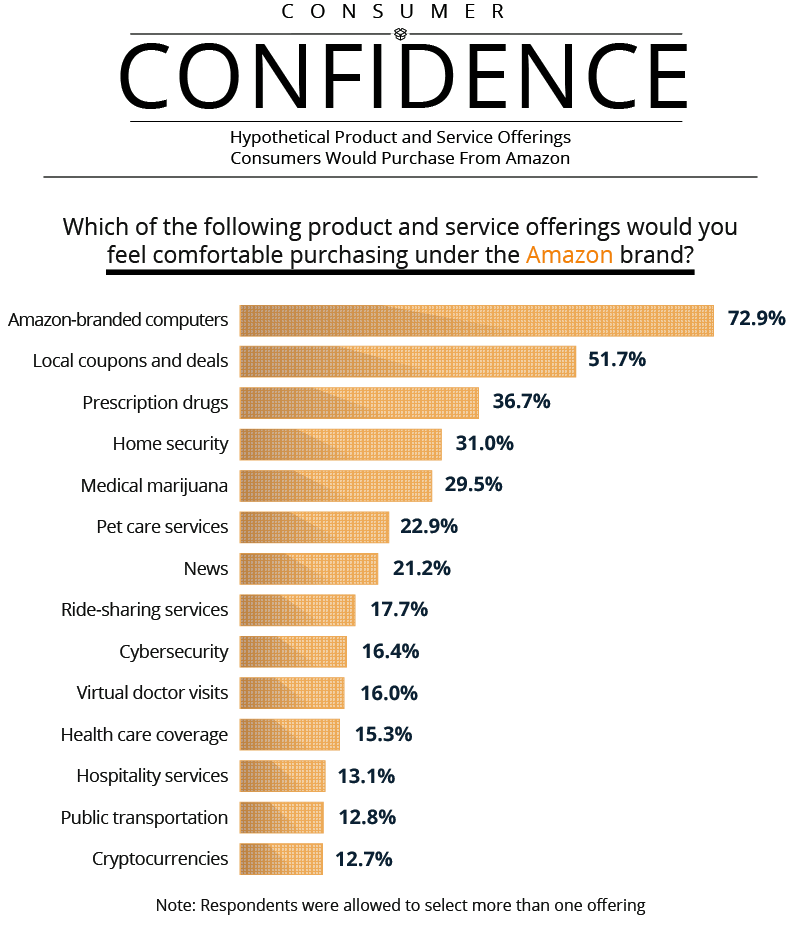 As for Amazon, Investing.com just-released a survey conducted among Prime members asking what kinds of products these ecommerce shoppers would be keen to buy from the site. Health-oriented goods and services ranked highly along with the usual fast-moving consumer goods suspects.
As for Amazon, Investing.com just-released a survey conducted among Prime members asking what kinds of products these ecommerce shoppers would be keen to buy from the site. Health-oriented goods and services ranked highly along with the usual fast-moving consumer goods suspects.
Emerging categories, like medical cannabis, CBD gummies, was also a new-new thing to add to the growing menu of possible healthy things Amazon could channel.
This is continued evidence that in 2019 and the near-term future, Amazon continues to “prime” consumers for experience. Price transparency, consumer reviews, and fast-shipping feature high on Prime shoppers’ love-list of features. These facets of consumer experience are bleeding over into peoples’ expectations for health care.
At HIMSS19, we’ll see this play out, through the fast-growth of voice assistants, price transparency and appointment-scheduling tools, and platforms for health benefits self-service.
See you on the show floor, or at any of my four public meet-ups this week, linked here:
Tuesday 12 February, 3 pm – Women in HIT Meet-up – Changing the Scales to #BalanceforBetter,
HIMSS Spot, Hall C
https://www.himssconference.org/session/womeninhit-meetup-changing-scales-balanceforbetter
Tuesday 12 February, 4 pm – Meet the HIMSS Social Media Ambassadors, HIMSS Spot, Hall C
https://www.himssconference.org/session/meet-himss-social-media-ambassadors-1
Wednesday 13 February, 8 am – Microsoft Health Forum and Innovation Awards
https://www.himssconference.org/education/microsoft-health-forum
Thursday 14 February, 10:15 am – PCHA Consumerism of Health Forum– Digital Traction of Consumerization of Health Care panel with leaders from Walgreens, Heal, and Cleveland Clinic
https://www.himssconference.org/session/digital-traction-consumerization-healthcare
PS — For more insights into Epic, see a New York Times article published December 23, 2018, titled, “Willy Wonka and the Medical Software Factory.” This story takes us into the inner sanctum of Epic, and begins: “In the farm country of southern Wisconsin, 12 miles from Madison, is one of the nation’s biggest tech companies – and almost certainly the quirkiest.” It is a must-read for any HIMSS19 attendee.


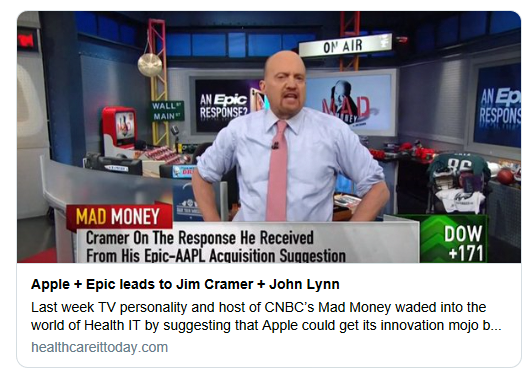


 Thanks to Feedspot for naming this blog, Health Populi, as a
Thanks to Feedspot for naming this blog, Health Populi, as a